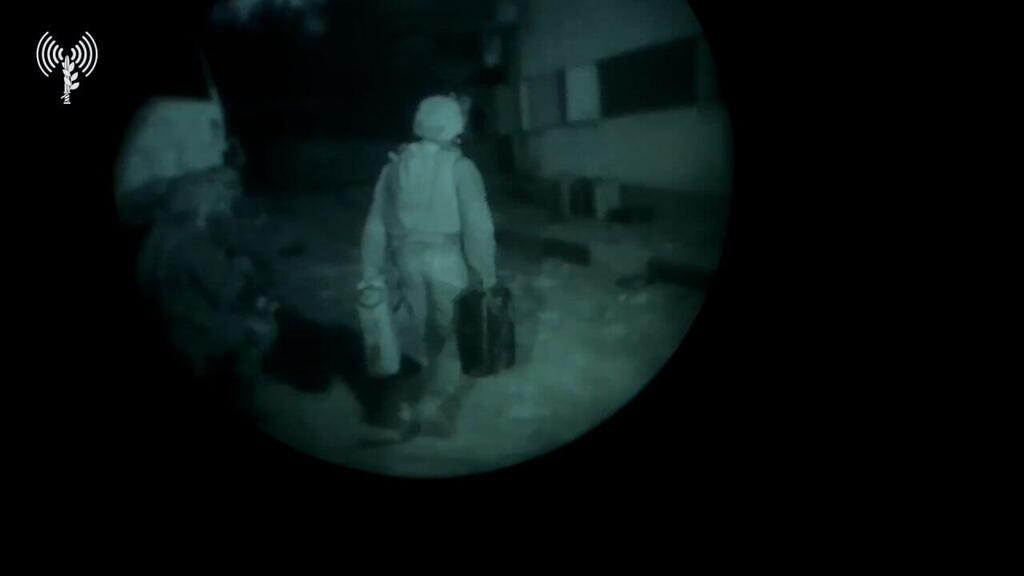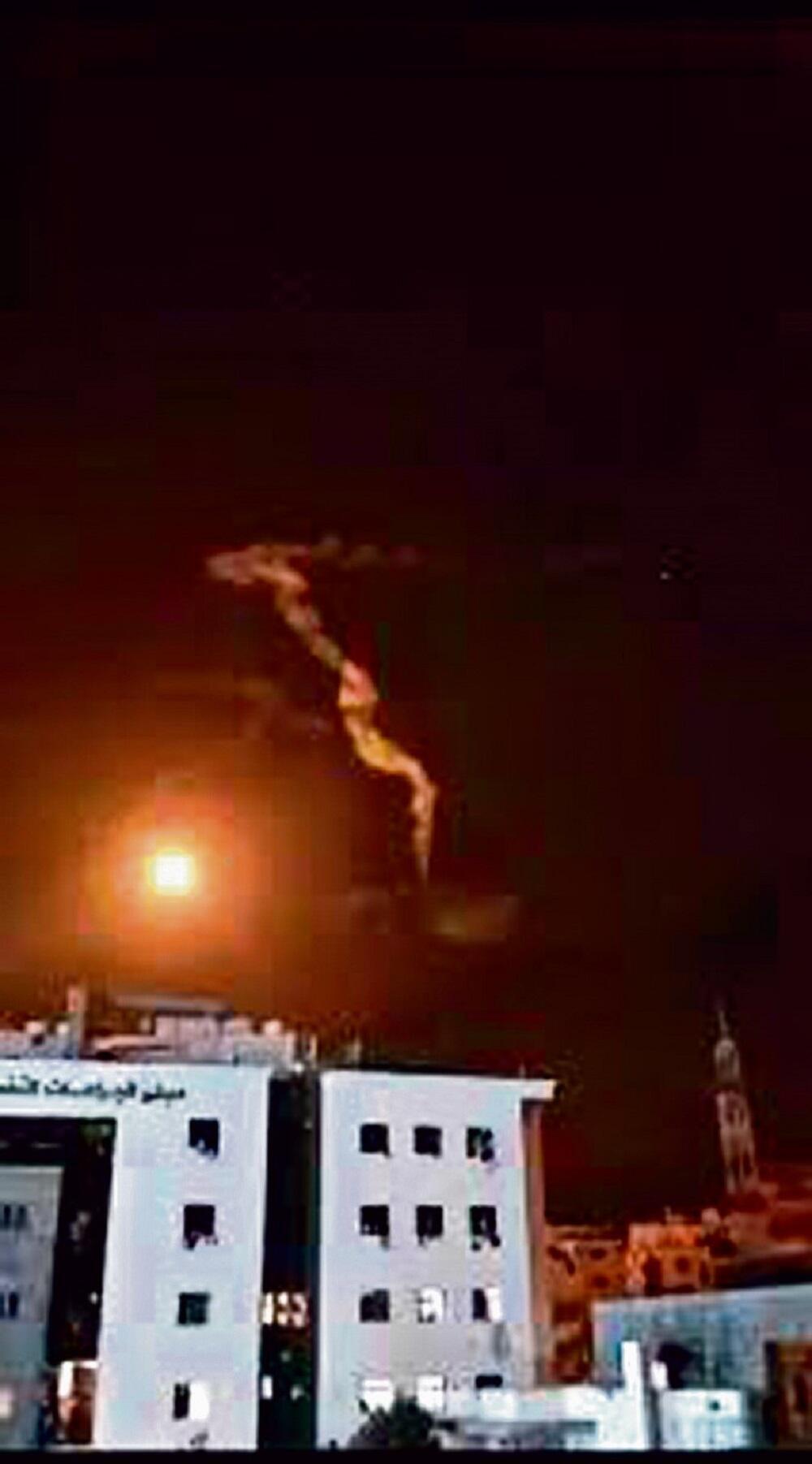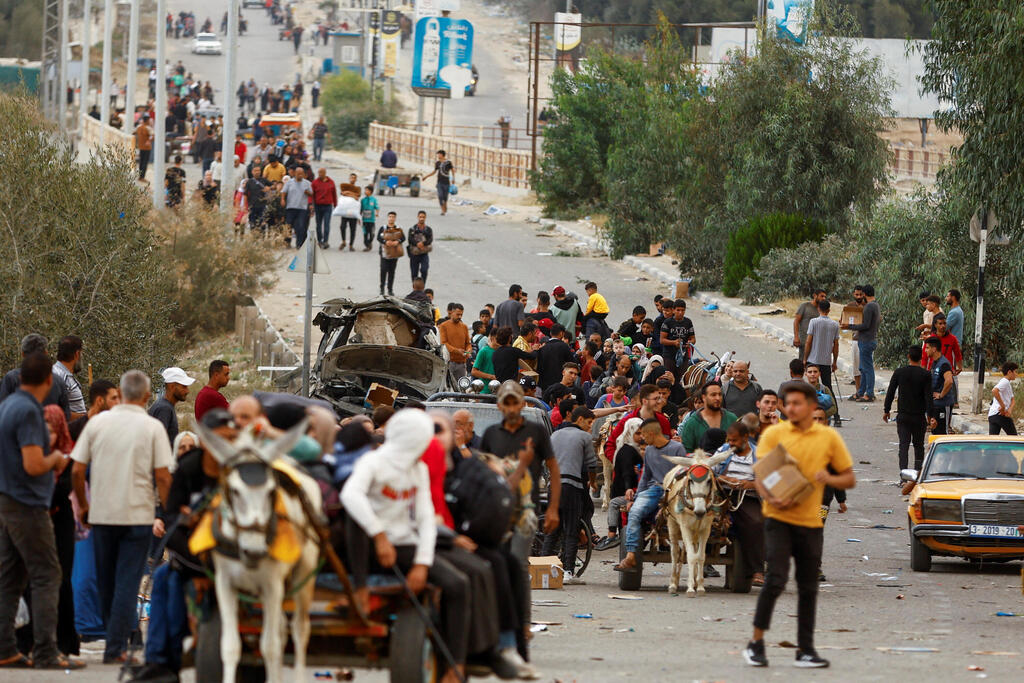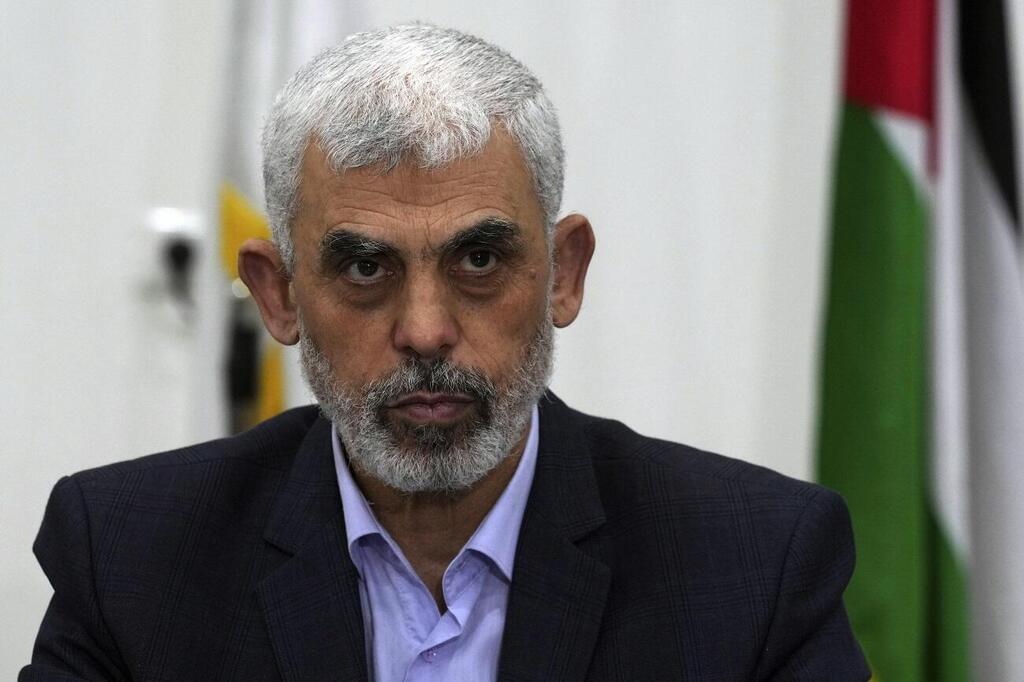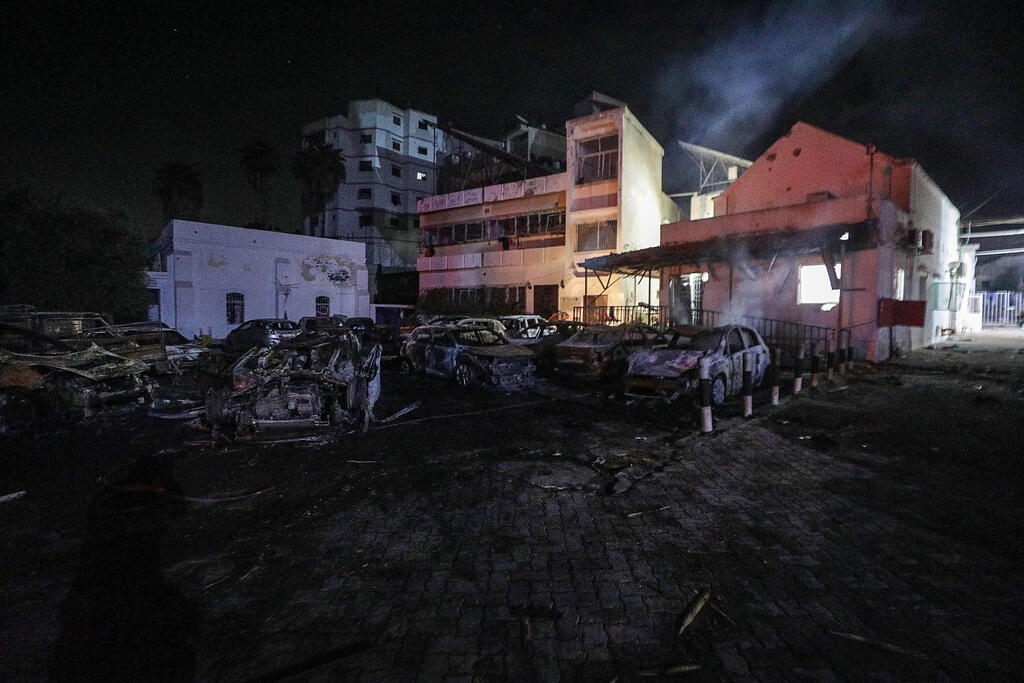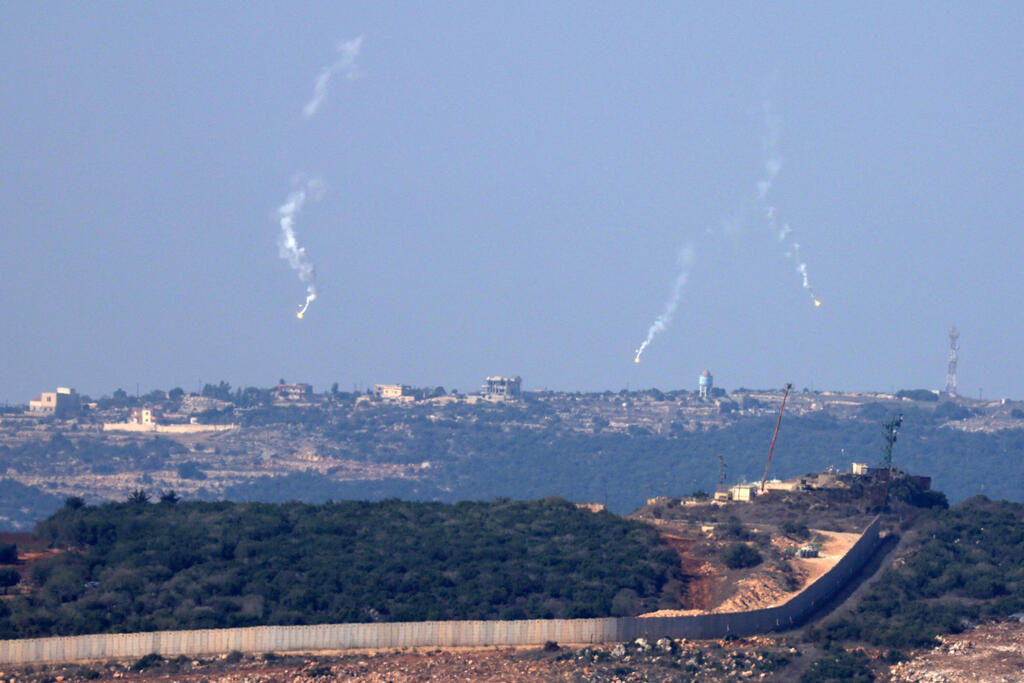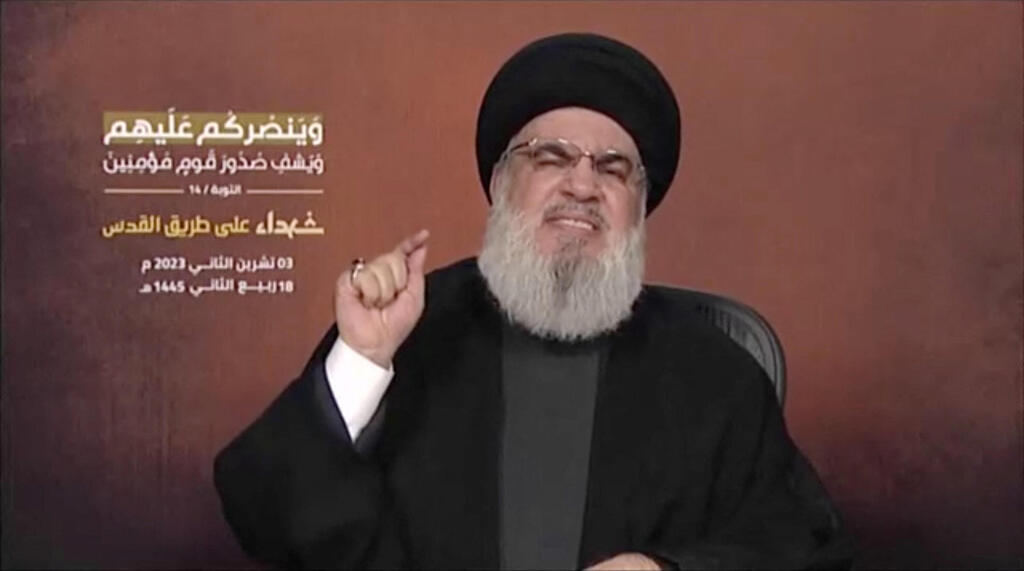Getting your Trinity Audio player ready...
Deep inside the Gaza Strip, on the night of November 12, as the conquest of Al-Shifa Hospital was still far off, IDF forces received a rather unusual order: Soldiers were asked to take dozens of jerry cans containing 65 gallons of diesel fuel and place them 650 feet from the hospital entrance.
More stories:
That night, a convoy of armored personnel carriers (APCs), accompanied by armored corps forces, set out toward the target. The IDF forces placed the jerry cans at the exact spot marked for them on the map – deep inside hostile territory beset with terrorists – and then returned.
At the same time, an officer from the Coordinator of Government Activities in the Territories (COGAT) called a source at the management of Al-Shifa Hospital. “We’ll place the fuel at the intersection of Omar El-Mukhtar Street and Nasser Street,” the officer stated. “Our forces will then retreat and the fuel will remain there. Send an ambulance to collect the fuel from there.”
This strange operation next to Al-Shifa Hospital that night was enormously important for the IDF and for the battle for public opinion Israel is currently conducting. “The Palestinians kept claiming that there was a fuel shortage at Al-Shifa,” explains a source involved in the operation’s planning.
“In response, Israel said ‘No problem. I’ll take my soldiers at night, and they’ll place the fuel next to the hospital.’ This creates a win-win situation: If the Palestinians take the fuel, you can say to the international community: ‘Look. Israel’s helping them.’ If they don’t take the fuel, you’ve proven the extent of Hamas’s indifference to hospital patients.“
It almost goes without saying that the fuel was never picked up. The IDF spokesman, Brigadier General Daniel Hagari, also stressed this in his press briefing the next day. “We’re waiting for them (Al-Shifa management) to pick up the fuel, but Hamas leadership won’t let them.”
The same source involved in planning the operation further said that Hamas does understand the ongoing PR battle between themselves and the IDF. This time, the IDF had the upper hand.
“Operation Jerry Cans” was just one in the complex battle for public opinion regarding Al-Shifa conducted by the IDF. The hospital has become a symbol, and is regarded by Gazans as a “safe shelter”. From the very beginning, it was a primary target for conquest, while constituting a “humanitarian stake-out”, likely to make the IDF look like they’re harming civilians, hospital patients and medical personnel.
So, the IDF asked non-involved parties to distance themselves before forces entered. This is why a week before “Operation Jerry Cans”, as IDF ground forces were still at a distance from the hospital, flares were suddenly spotted in the sky over Al-Shifa Hospital.
Looking back, the flares served less as illumination, and more to convey a message: The Israeli army is approaching. Four days later, in Al-Shifa they began hearing gunfire and explosion booms right outside the door.
According to one media report, the IDF even took down a tall building adjacent to the hospital. The IDF spokesman was sure to report to Israeli media that “tanks and infantry on ‘Namer’ APCs are closing in on Al-Shifa Hospital and further hospitals as part of advancing into the heart of the city.” One may assume that this message was aimed more at Palestinian than Israeli ears.
Three days after that, those still remaining in Al-Shifa started seeing the IDF with their own eyes. “An Israeli tank is standing at the entrance to Al-Shifa’s outpatient clinic” declared the spokesman for Hamas’s Ministry of Health. Doctors claimed that “Israeli tanks are inside the complex, and there are snipers on all surrounding buildings.“
If the flares, explosions and tanks were the stick, the IDF also provided those still inside Al-Shifa with a carrot: As reports of the IDF’s entrance were mounting, a humanitarian corridor was opened up, allowing people to exit southward. The IDF conveyed a clear message to those present, advising them to evacuate as soon as possible. Hospital staff also received phone calls from IDF personnel, clearly outlining the course of the evacuation route from the hospital.
It worked. Thousands of Gazans who had gathered in and around the Al-Shifa complex began moving along the southbound route set out by the IDF. According to an IDF source, even Hamas - some of whose men had warned that the IDF was about to storm the hospital and massacre everyone – facilitated the escape.
“When Hamas themselves say ‘The IDF will be here any minute’, they’re scaring the Palestinians inside the hospital,” the same source tells us. “The average Palestinian says to himself ‘I’ll take my chances and flee south. I’m not staying here.’ He doesn’t want to die or become a human shield. In the beginning, there were about 40 thousand people in Al-Shifa. By the end, there were only a few hundred Gazans still left there.“
Mission accomplished. Relatively little live fire was used in this battle, but a great deal of ammunition of another kind was: The kind aimed at the thoughts and minds of the Palestinians. Distancing civilians from Al-Shifa is a clear example of what the IDF calls “psychological warfare”. This concept, although abundantly thrown around during this war, for the most part remains a mysterious enigma.
Psychological warfare is a subtle, sophisticated and time-honored craft that relies on methods borrowed from the realms of psychology and marketing and includes endless covert and overt methods. In its crudest form, psychological warfare is used to aid fighters in the field. IDF moves to precede the conquest of Al-Shifa Hospital were designed to shape global public opinion, as well as serve to aid the focal target of the ground operations stage in the northern Gaza Strip: The physical conquest of the hospital.
“At the end of the day, psychological warfare aims to decrease opposition in the field,” explains Lieutenant Colonel (Res) Dr. Raveh, who has researched psychological warfare in depth. “The power of psychological warfare is not the power to kill, but the power of persuasion. It’s about how to convey your information to the other side in a way that will influence them. So, psychological operations will invariably have one central characteristic.”
And that is?
“Creativity”.
Influence campaigns
The IDF’s Information Operations Branch is responsible for the creativity behind its psychological warfare. This is a new unit, founded five years ago by then-chief of staff Gadi Eizenkot. It aims to centralize all IDF psychological warfare matters, which had formerly been scattered among various branches.
Although the unit, commanded by an officer holding the rank of colonel, is made up mainly of Intelligence personnel, it belongs to the Operations Division within the Operations Directorate. This testifies to the importance the IDF attributes to psychosocial warfare within the battle process.
In the Information Operations Branch, Intelligence personnel work alongside personnel from Operations and Technology, researchers of Islam and Arab culture, as well as quite a veritable number of copywriters and people working in “creative” departments in fancy Tel Aviv offices – as far away from Gaza as could be. “The Information Operations Branch is a kind of advertising agency”, says a source familiar with the unit’s work.
“There are guys there who usually work for advertising firms who are recruited as part of their reserve duty - even with no background in military psychological warfare. The problem with advertising people is that they’re quite removed from Arab culture. They might come up with an idea that’s great, but would never work on the other side.”
The unit also includes representatives from the Mossad and Shin Bet, the National Security Council, Foreign Office as well as from the IDF Spokesperson’s Unit and Coordinator of Government Activities in the Territories. The idea is to combine forces to formulate what’s known as an “advertising campaign”. Yes, it’s a kind of advertising agency aiming at being as persuasive as possible for the target audience, be it people taking refuge in Al-Shifa Hospital, demonstrators in London, or the president of the United States.
“It’s a very diverse mix of professions, that together have created a discipline that hasn’t existed until now in the IDF “ the same source continues. In the unit, you have the planning body that builds strategy, followed by the executive body that details this strategy – i.e. the central message you want to convey – into action.”
The IDF refused to collaborate with this article. “Psychological warfare is a problematic grey area” they explained. Our conversations with former IDF psychological warfare sources provide us with insights as to how the system works. “In the IDF, they work by the American doctrine,” says Dr. Raveh.
"The first stage in any operation is intelligence gathering. But unlike intelligence based on visual intelligence (VISINT) and signals intelligence (SIGINT), psychological operations are based on open-source intelligence (OSINT), i.e., information openly available on social media. Through this, you can gauge the mood on the other side, what it’s influenced by, how it thinks, etc. You then operate accordingly. You’re learning the enemy in a precise manner and you understand how it sees things. Then you try influencing it.”
Raveh says that conveying messages to the other side can be conducted “using three materials: White, grey and black.”
What do you mean?
“White material is visible material that the other side knows comes from official spokespersons, including from the security establishment. Gray material is material that you put out while you’re in disguise, but you’re not bothered if people know it’s you – like spreading information via online influencers’ accounts. In this case, Israel doesn’t care that everyone knows who’s behind the information, but she doesn’t want to be the one visibly behind this information. “
And what’s black material?
“This is when information is disseminated conveying information that is not visible, alongside information that is visible - i.e. covert operations.“
Can you give us an example of the use of “black information”?
“I really can’t.”
Raveh is willing to tell us about a psychological “campaign” – that can target an entire population or a specific subgroup of that population. “It’s all about the target demographic and what you’re aiming to achieve,“ he says.
How do you carry out such a psychological campaign?
“You create a situation that they believe. Then, through this situation, they make decisions to your advantage.”
How does it feel playing with people’s emotions?
“We have boundaries. We limit ourselves – unlike the Russians or Hamas. We have a lot of discussions about values, whether or not what we’re doing is proper. There’s a lot of ethics in this field.”
What wouldn’t you do for example?
“You wouldn’t lead a family to a place where they’ll get killed, or convince them to stay in their home if it’ll likely result in their deaths. These are things our enemy does. We don’t. Generally, we wouldn’t do something because of which someone will get killed.“
Even if that person is Yahya Sinwar?
“There are exceptions.”
Proving the lie is a lie
Israel clearly doesn’t have a monopoly over psychological warfare. The other side, in this case Hamas terrorists, also employs such tactics. The classic example was the failed Islamic Jihad missile that hit Al-Ahli Hospital on October 17. IDF sources even claimed that they were unaware of the explosion at Al-Ahli until they heard about it from Al Jazeera which relied on Hamas sources. Within a very short time, Hamas announced that 500 people had been killed at the site.
“It was a brilliant move on the part of Hamas. And it took them a millisecond: You have a disaster. You immediately attribute it to the enemy,” says Dr. Ron Schleifer, senior lecturer in the School of Communication at Ariel University, specializing in psychological warfare.
“In psychological warfare, it’s called ‘exploiting opportunities.’ The battle is around ‘who’s responsible’ and the first one to attribute blame is the winner. So, Hamas first say, ‘Israel did it’, followed by ‘500 dead.’ Why 500? Because 1000 is too high for one explosion, and 200 isn’t dramatic enough, so they go with the figure of 500. It’s a round number and they disseminate this number worldwide. Now, Israel must not only prove that she’s not responsible for the blast, but also that 500 people weren’t killed.”
'Hamas exaggerate casualty numbers in hospitals, they show us there’s no electricity when there is, they lie about how often they hit our soldiers and APCs. They’re not having any success, so they’re primarily busy lying'
“Another advantage Hamas has is that it has a much shorter chain of command. It’s no problem for someone to get some ketchup, daub it over some children, photograph it and distribute the pictures. The IDF would never approve such an operation. Even if it did, the approval would take months.“
So, the day after the incident, following a detailed investigation, the IDF spokesman’s office published an official statement explaining that the explosion at Al-Ahli Hospital resulted from a failed rocket launch. At the same time, the IDF published a recording of an incriminating conversation between two Islamic Jihad operatives, reinforcing the IDF’s claims. Although the recording exposed an IDF intelligence source, it was largely successful in establishing the Israeli narrative, at least in the eyes of the person widely regarded as the most powerful man in the world.
“Based on what I've seen, it appears as though it was done by the other team, not you," U.S. President Joe Biden said on he visited Israel at the time.
“In operations against Islamic Jihad in recent years, when rockets have killed Gazan civilians, we quickly managed to prove that the explosion resulted from a failed rocket launching,” says Dr. Raveh.
“In the case of Al-Ahli Hospital, it took us longer. Hamas had no problem lying and claiming that Israel caused the casualties. We, on the other hand, had to prove that they were lying. But ultimately, when we exposed the Hamas story as fake, it made Hamas look bad.”
Hamas clearly has no problem lying. We’re actually fighting them with one hand tied behind our back.
“Yes. We’re at a disadvantage against Hamas as they’re constantly busy disseminating lies, which are accepted as true – mainly in the Muslim world. Hamas exaggerate casualty numbers in hospitals, they show us there’s no electricity when there is, they lie about how often they hit our soldiers and APCs. They’re not having any success, so they’re primarily busy lying. Their lies then resonate because Al Jazeera doesn’t check the reliability of their own reports or videos. It’s very hard for us to prove that a lie is a lie. It’s like proving you don’t even have a sister. We have certain standards. The other side doesn’t.”
The psychological warfare of the Intifada
Psychological warfare has always been part of war. “It’s existed since antiquity,” says a source involved in psychological warfare in Gaza. Take, for example, the Arch of Titus. This is psychological warfare: Placing a huge arch in the middle of the city with a frieze of Jews being taken into exile is designed not only to glorify its builder, but also to show everyone who sees the arch ‘Look what happens to anyone opposing us.’ Today, we’d call it ‘demoralization efforts’.”
"From her early years, to score international legitimacy, Israel has also been known to use psychological warfare to brand military conflicts as 'defensive wars' or 'few against many.' But all this changed with the first Lebanon War and the first Intifada. During the war in Lebanon, despite Israel’s success in defeating the PLO, the force used against Lebanon’s civilian population, the siege of Beirut and the massacres at Sabra and Shatila, led to cracks in both international and internal legitimacy for the war. In the West Bank and Gaza too, the Palestinians managed to present Israel as a cruel occupying force.”
“What we saw in the first Intifada was a massive orchestrated Palestinian psychological warfare campaign,” says Dr. Schleifer. “In hindsight, it turned out that the Palestinian doctrine was that of North Vietnam. It might be summed up in a single sentence: "The war, more than being conducted in the jungles of Vietnam, was conducted on the streets of Washington. It took Israel some time to understand this.”
It was only in the early 2000s, after Israel’s withdrawal from Lebanon and the second Intifada, that IDF concluded that to counter the PLO, Hamas and Hezbollah, we also need take serious steps to develop our psychological warfare.
During Yaalon’s term as chief of staff, a team was set up to study psychological warfare and develop it within the IDF. The team recommended setting up a broad system that would not only deal with classic psychological warfare, but also concentrate all matters regarding public opinion and information warfare – as in the American army. These recommendations were not ultimately adopted in full. Only one of these recommendations was accepted – establishing an operations body responsible for psychological warfare operations.
In 2005, an Israel Defense Forces Operations Directorate unit specializing in psychological warfare was founded - known as “Malat”. It was part of the Military Intelligence Directorate and focused on operations against the adversary, but did not deal with hasbara, or as the IDF used to call it, “legitimization”.
Malat took its first steps as an active and creative player during the 2006 Second Lebanon War. Shortly after the beginning of the campaign, Malat prepared 47 different fliers that were dropped almost nightly over Lebanese territory – a total of 17 million units. These fliers primarily aimed to convey to the population in Lebanon the message that Nasrallah was exploiting them and leading the way to Lebanon’s destruction.
“An idea came up to use the parable of the scorpion that stings the frog who helps him cross the river,” a source involved in Malat (Israel Defense Forces Operations Directorate unit which specializes in psychological warfare) at the time tells us.
"It’s a parable that we know in Israel, but we’re weren’t sure whether they knew it in Lebanon. We consulted an expert in Lebanese culture - one of the last Jews to leave Lebanon. We understood from him that this parable is also well-known in Lebanon. We conducted an overt ‘mini-campaign’. We dropped a flier with a caricature showing Nasrallah as the scorpion and Lebanon as the frog. At the same time, we prepared a radio segment around the theme, and broadcast an animated video about the parable.”
“Another imaginative idea Malat came up with was dropping over Lebanon scented tree air fresheners – like the ones you hang on the front of your car. There was a picture of Nasrallah on the tree with the words ‘Leave us with a good scent.’ This campaign was based on an idiom, well-known in Lebanon but not in Israel. ‘Leave us with a good scent’ actually means ‘Go to Hell. Just disappear,’" the Malat source explains. “Incidentally, we debated what scent the tree should have. We thought it might emit a bad smell, but in the end, we went with the scent of the cedar tree – identified with Lebanon. “
While the IDF was using fliers and little scented trees, Nasrallah used television to convey his message. These messages were well received. And not just in Lebanon.
“During the Lebanon War, Israeli media was broadcasting Nasrallah’s speeches during prime time,” the same Malat source claims. “Coming from psychological warfare, it drove me crazy. I’d have to turn backflips to get myself onto Lebanese prime time. We were both giving him an open platform and glorifying him.
"At some stage, we approached the media outlets and said ‘There’s nothing wrong with telling your audiences the main points of what Nasrallah says - it’s important. But don’t broadcast 20 minutes of Nasrallah live. The Israeli media only started paying attention after the Israeli navy’s flagship, the INS Hanit, was hit – an incident reported live by Nasrallah – greatly pushing up his credit rating."
They also did a huge lead-up for Nasrallah’s big speech at the beginning of November.
“But it came from Lebanon rather than from Israel. They had promos and clips for this speech. I’ve never seen a Lebanese lead-up like this for a Nasrallah speech. I was pleased to see that this time around, the Israeli media didn’t broadcast the speech live. In Lebanon, they wanted to create hype around Nasrallah, but I think this time it was a mistake. After the lead-up, he didn’t actually say anything and looked like a loser. Nasrallah is losing traction within Lebanon right now.“
Malat carried on after the Second Lebanon War. During Operation Cast Lead (2003-2004), they dropped fliers instructing the Gazan population how to conduct themselves and that included information on humanitarian matters, such as where and when food distributions would take place. During the campaign, the IDF took control of Hamas’s radio and television channels and conveyed messages to the local population over news bulletins complete with video intros.
At Malat, they were very pleased with their own activities in Lebanon, but the IDF thought otherwise. With all due respect to the filers and taking over news broadcasts, army leaders concluded that psychological warfare must be integrated into a broader campaign for public opinion rather than remain a separate field.
Malat was disbanded in 2018. Its capabilities were then dispersed over various units, as mentioned, primarily to the Information Operations Branch that synchronizes all the IDF’s psychological warfare, public opinion and hasbara operations. Dr. Raveh was a senior Malat official and was involved in setting it up. “Disbanding Malat wasn’t such a clever move. Psychological warfare is a profession. Malat based itself on knowledge and people who worked in the field full-time. The army regretted disbanding the unit.“
However, Tamir Hayman, who served as head of the IDF’s Military Intelligence Director when Malat was disbanded says that “the unit was indeed disbanded, but that doesn’t mean that psychological warfare has been abandoned. Quite the opposite: We’ve reinforced the field by strengthening our ability to implement it. This requires operational capability. Without this, we just have ideas. The bottom line is that instead of a single unit with good ideas but no ability to implement them, we’ve created a number of units, each of which has its own technological operations body dedicated to psychological warfare. Results came quickly as we used these units in CBW (Campaign Between Wars).”
Ripping the mask off
The Influence Unit is also operating in the present war in coordination with other IDF elements. A source involved in the unit’s activity in the present war tells us “We doing both offensive and defensive.”
A recent unit operation homed in on the Hamas spokesman known as Abu Obaida, who has a habit of appearing in front of the cameras with his face covered with a keffiyeh. In a video posted by the IDF spokesman’s office in Arabic last month, the keffiyeh was “removed” from his face and the Hamas spokesman’s face was exposed. At the same time his real name, Hudhayfah Kahlot, was revealed. “Exposing the face of the Hamas spokesman is nothing new. It was done during Operation Cast Lead” the same source tells us.
So why do it again?
“Because the Hamas spokesman appearing behind a mask creates a kind of primordial fear. It’s like the Masked Man, Zorro or Batman. Hiding behind a mask is a Hamas’ tactic. They’ve made it iconic. Here, we’re saying to them ‘Look, he doesn’t look so threatening behind the mask.’ The moment you expose his face to Israelis, Palestinians and others, you’re saying ‘Look at this ugly guy. He’s just not that scary’.”
8 View gallery
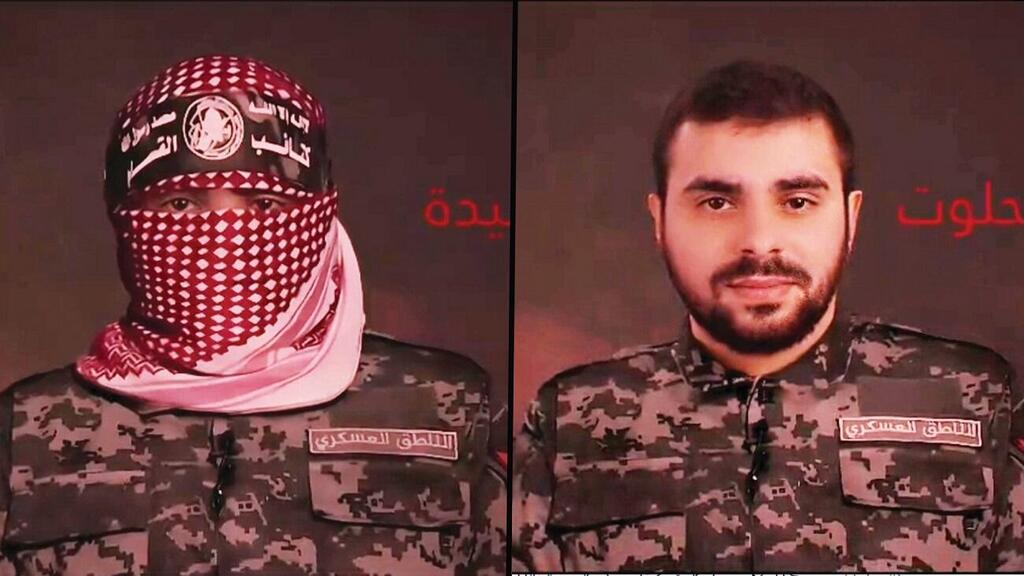

Uncovering the face of Hamas spokesman Abu Obaida, AKA Hudhayfah Kahlot
(Photo: IDF Spokesperson's Unit)
A further extensive Influence Unit operation targeted the population of North Gaza as part of the IDF’s efforts to clear the area of civilians to facilitate ground operations. As early as October 13, the IDF dropped fliers from the air reading “Hamas terrorists are hiding in Gaza City in tunnels beneath homes, and buildings heavily populated with innocent civilians. Gaza residents – make your way south for your own safety and that of your families. Distance yourselves from Hamas terrorists who are using you as human shields.”
At the same time, Al Jazeera broadcasts in Gaza showed a video clip of IDF’s attacks on Gaza, with a ticker below warning residents to flee areas where there are terrorists. It read: “Every target and every terrorist will die. Flee while you can.”
The following day, Major General Ghassan Alian from COGAT addressed Gaza Strip residents, writing on Facebook: “The IDF is fighting Hamas and the IDF will destroy Hamas. Hamas has brought this war upon you – and its defense is enjoying itself in hotel spas, or hiding underground in tunnels.” At the beginning of November, the IDF dropped fliers over the Gaza Strip calling on civilians to supply information they may have regarding people who were kidnapped in exchange for monetary rewards and “a better future.”
The Influence Unit knows that these fliers are ineffective if not accompanied by actions. “If you ask them nicely to move south, it won’t necessarily happen,” says Dr. Raveh. “But if you create a feeling of fear and danger, and then ask them to evacuate, it’ll work better. You’re trying to convince civilians first by the use of fliers. You then step up the pressure, like with gunfire. Sometimes the purpose of gunfire operations isn’t necessarily to kill, but rather just to convince residents that it’s best they leave their homes.
“Because the Hamas spokesman appearing behind a mask creates a kind of primordial fear. It’s like the Masked Man, Zorro or Batman. Hiding behind a mask is a Hamas’ tactic. They’ve made it iconic. Here, we’re saying to them ‘Look, he doesn’t look so threatening behind the mask.’ The moment you expose his face to Israelis, Palestinians and others, you’re saying ‘Look at this ugly guy. He’s just not that scary’.”
"You can also use fliers and there are further methods to ultimately make them leave. All of these tools are in the arsenal. At first, they didn’t respond to our stories, among other things, because Hamas were preventing them from leaving. At the end of the day, they realized that military pressure was increasing and they would die if they didn’t leave. So, they responded much quicker. It’s a game of words and lethal force.”
And after all this, we have to talk about the Day After. Psychological warfare doesn’t end with fighting in the field, but rather keeps working to instill the final narrative of the war. Victory isn’t just defeating Hamas’s terrorists or killing Yahya Sinwar or Mohammed Deif,” explains Dr. Raveh. “The question is how the population in Haza perceives the Israeli victory and vice versa.”
As one who knows the other side, what will make them recognize Israel’s victory?
“First of all, they need to understand, unequivocally, that Hamas will no longer rule the Gaza Strip. But the second dimension is to make them believe they have alternatives, that something better can come out of the war for them.”
It doesn’t look like we’re at that stage yet.
“Israel’s mood is now in that of revenge. And rightfully so. Telling Gazans that something good will happen in the future, isn’t applicable right now. What they see now is the catastrophe that has befallen them – leaving their homes and moving around from place to place. The next phase hasn’t started yet. And when it does, it’ll take a very long time.”



